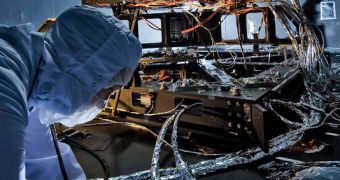Engineers at the NASA Goddard Space Flight Center (GSFC), in Greenbelt, Maryland, are making consistent progress in putting together the next-generation James Webb Space Telescope (JWST). Currently, they are preparing a series of special optical equipment for environmental testing.
In the image to the left, GSFC expert engineer Erin Wilson is seen as he is coating a series of electrical cables in aluminum tape, in order to make them cold resistant enough to withstand the harsh conditions of outer space.
A special chamber will then be used to replicate the conditions that the JWST will experience once it reaches its destination, the L2 Lagrangian point. This is a location about 1.5 million kilometers away, where the telescope will remain in the same position relative to the Sun-Earth-Moon system.
Once it reaches L2, the JWST will unfurl its tennis court-sized sunshield, and turn it towards the three celestial bodies. This will play a dual role – enable it to prevent stray photons from entering its sensitive detectors, and keep the observatory's temperature down to near absolute zero.
These are extremely harsh conditions for electronic equipment of any kind, and it's the purpose of these environmental tests to ensure that they are up to the task. One of their most important points is to verify the alignment of the actual flight instruments that will go on the JWST.
“Because the flight science instruments detect infrared light, they must be extremely cold to work, and so the environment we test them in must be extremely cold too,” Wilson explains. The thermal-vacuum chamber that will be used for these tests is called the Space Environment Simulator.
Wilson recently prepared the Optical Telescope Element (OTE) Simulator (OSIM) for environmental testing. In the image to the left, the equipment in the background is the Beam Image Analyzer, an instrument that will be used to measure the performances of OSIM.
The actual Simulator is located beneath the platform that Wilson is seen working on. It is about two stories tall, and occupies the entire test chamber in diameter. The JWST is by far the largest and most complex space telescope ever built. Putting it together will cost NASA around $8.8 billion.
“It has taken a little over a month to get temperatures cold enough to duplicate the temperatures that Webb will see in operation in space,” concludes the manager for OSIM and the JWST Integrated Science Instrument Module (ISIM) Electronics Compartment, Robert Rashford.

 14 DAY TRIAL //
14 DAY TRIAL //